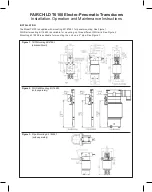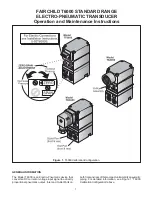
j. Turn R8, HIGH power modulation monitor sample adjust-
ment, on Output Monitor fully CCW.
k. Turn the transmitter on at HIGH power, or, if the transmit-
ter is already on at another power level, depress the HIGH
power switch. Use the RAISE and LOWER buttons to set
the HIGH power output.
l. Adjust R8, on Output Monitor, until the sample voltage at
the modulation monitor is the SAME as it was in the LOW
and MEDIUM position.
m. Switch between LOW, MEDIUM, and HIGH power to
verify that the Modulation Monitor sample is the same for
all three power levels. If necessary, readjust R7 or R8 so
that all sample voltages are the same.
2.15.9
Modulation Check
During the modulation check, it is helpful to monitor the RF
envelope on an oscilloscope connected in parallel with the Modu-
lation Monitor RF sample. Check for proper modulation at
various power levels, as follows:
a. Connect an audio generator to the audio input.
b. Turn the transmitter on at LOW power. Apply a low level
audio sine wave at 1 kHz. Increase the generator output
until modulation level is approximately 50%.
c. Observe the modulated RF signal on the oscilloscope. The
modulation envelope should be a smooth sinewave, with
no steps, notches, or other distortion. (If a distorted enve-
lope is observed, check the audio generator output with the
oscilloscope before assuming there is a transmitter prob-
lem. Sometimes, defective test equipment is the problem
rather than the equipment being tested).
d. Switch to MEDIUM and then to HIGH power. The trans-
mitter will maintain the same modulation level. Again,
observe the modulated RF signal on the oscilloscope. The
modulation envelope should still be a smooth sinewave.
e. Increase the modulation to 95% negative peak modulation.
Observe the waveform again at all power levels.
f. Check all meter readings against the Factory Test Data
sheets for meter readings with modulation. Meter readings
should be close to factory readings.
g. Note that the front panel CURRENT meter reading depends
on power output AND modulation level. The meter reads the
average current returning to the PA Power supply. Because
PA voltage is fixed, PA current depends on transmitter output
power, which varies with modulation.
2.15.10
Setting Audio Input Level
The Audio Input sensitivity of the transmitter is adjusted with the
AUDIO GAIN ADJ control, R15, on the Analog Input Board.
The Analog Input Board is located below the Output Monitor on
the left wall of the Center Control Compartment. Use the follow-
ing procedure for this adjustment:
a. Determine the stations’s reference audio level for 100%
modulation. (Typical levels are 0 Dbm or +8 Dbm, but the
transmitter can accommodate reference levels from -10
dBm to +10 dBm at 600 Ohms.)
b. Switch the transmitter to MEDIUM power. Set the output
level from the audio generator to the station’s reference
value for 100% modulation. (If you are using an output
level meter on the audio signal generator, be sure that the
generator is operating into the proper impedance. Some
audio signal generator meters are accurate only with the
correct load.)
c. Using R15, Audio Gain Adjust on the Analog Input Board,
adjust for a modulation level of 100%, as read on the
modulation monitor. This completes audio input level ad-
justment.
2.15.11
Audio Input Phasing Check (Optional).
This is not a transmitter check, rather, it is a system check. The
50kW transmitter version is capable of positive peak modulation
of +125% or greater at 55 kW carrier power, and even higher
positive peak modulation at 25 kW or less. An audio phasing
check may also be included in the manuals for the audio proc-
essing equipment.
In the United States and many other countries, positive peak
modulation up to +125% is permitted. If regulations at your
location permit, and you have audio processing equipment with
asymmetrical output, you may wish to verify that your audio
input is phased correctly. Proceed as follows:
a. You will need a program source or audio frequency gener-
ator with asymmetrical output, audio processing equip-
ment capable of providing positive peaks over +100%, and
a modulation monitor with a negative 100% peak flasher
and an adjustable positive peak flasher. (An audio gener-
ator with an asymmetrical audio frequency output is ideal
for this check, but is not available at most stations).
b. Turn the transmitter on, at any power level, and modulate
with asymmetrical audio or with program. Adjust the
program level so that negative peaks just reach -100%.
c. Observe positive peak modulation levels.
•
If positive peaks are approximately 100%, you don’t have
a program source with higher positive peaks than negative
peaks, or possibly your processing equipment is not ad-
justed properly.
•
If positive peaks are LESS than 100%, try reversing the two
audio signal leads, either at the audio output supplying the
transmitter or at the transmitter audio input terminals.
•
If positive peaks are GREATER than 100%, your audio
input phasing is correct.
2.15.12
Controller Battery Backup
A 1 Farad capacitor supplies backup for AC power failures
shorter than 2 hours.
Three AA alkaline batteries are used for Controller power mode
and power level memory backup. These will enable the transmit-
ter to return to operation at the correct power level after an AC
power failure longer than two hours at 72 degrees F (25 degrees
C). The batteries should be installed AFTER the Low Voltage
DX-25U
2-12
888-2297-002
Rev. AA: 8/9/2000
WARNING: Disconnect primary power prior to servicing.
Содержание DX 25U
Страница 2: ......
Страница 10: ......
Страница 28: ......
Страница 32: ......
Страница 46: ......
Страница 58: ......
Страница 82: ......
Страница 150: ......
Страница 158: ......
Страница 166: ......
Страница 174: ......
Страница 176: ......
Страница 196: ......
Страница 206: ......
Страница 212: ......
Страница 218: ......
Страница 270: ......
















































